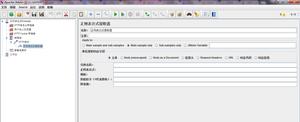带有示例的Python正则表达式?
正则表达式是一种编程语言,用于识别给定的字符(字符串)序列中是否存在模式。
正则表达式或Regex是一个字符序列,用于检查字符串是否包含指定的搜索模式。
正则表达式模块
要使用RegEx模块,python附带了名为re的内置包,我们需要使用正则表达式来使用它。要使用RegEx模块,只需导入re模块即可。
import re
示例
import retxt = "Use of python in Machine Learning"
x = re.search("^Use.*Learning$", txt)
if (x):
print("YES! We have a match!")
else:
print("No match")
输出结果
YES! We have a match!
正则表达式功能
re模块提供了几个功能,使我们可以搜索字符串以查找匹配项。
| 功能 | 描述 |
|---|---|
| 找到所有 | 返回包含所有匹配项的列表 |
| 搜索 | 如果在字符串中的任何位置找到匹配项,则返回Match对象 |
| 分裂 | 返回一个列表,该字符串在每个数学运算中均已拆分 |
| 子 | 用字符串替换一个或多个匹配项 |
元字符
RegEx中的元字符是具有特殊含义的字符。
| 性格 | 描述 | 例 |
|---|---|---|
| [] | 一组字符 | “[上午]” |
| \ | 发出特殊序列的信号,也用于转义特殊字符 | “ \ d” |
| 。 | 除换行符外的任何字符 | “他..o” |
| ^ | 以。。开始 | “ ^你好” |
| $ | 以。。结束 | “世界$” |
| * | 零次或更多次 | “ aix *” |
| + | 一个或多个事件 | “ aix +” |
| {} | 确切指定的发生次数 | “ a | {2}” |
| | | 两者任一 | “短|长” |
| () | 捕获并分组 | |
特殊序列
RegEx中的特殊序列是\,后跟以下所列字符之一,并具有特殊含义-
| 字符 | 描述 | 例 |
|---|---|---|
| \一种 | 如果指定的字符在字符串的开头,则返回匹配项 | “ \ APyt” |
| \ b | 如果指定字符在单词的开头或结尾,则返回匹配项 | r” \ bPython” r” world \ b” |
| \ B | 如果存在指定的字符,则返回匹配项,但不出现在单词的开头(或结尾) | r” \ BPython” r” World \ B” |
| \ d | 如果字符串包含数字,则返回匹配项 | “ \ d” |
| \ D | 如果字符串不包含数字,则返回匹配项 | “ \ D” |
| \ s | 返回匹配项,其中字符串包含空格字符 | “ \ s” |
| \ S | 返回字符串不包含空格字符的匹配项 | “ \ S” |
| \ w | 如果字符串包含任何单词字符,则返回匹配项(字符可以是从a到Z的字母,从0-9的数字和下划线_字符 | “ \ w” |
| \ W | 返回一个匹配项,其中字符串不包含任何单词字符 | “ \ W” |
| \ Z | 如果指定的字符位于字符串的末尾,则返回匹配项 | “世界\ Z” |
套装
RegEx中的set是在一对方括号[]中的一组字符,它们具有某些特殊含义。
| 组 | 描述 |
|---|---|
| [raj] | 如果存在指定的字符(a,r或n)之一,则返回匹配项 |
| [ar] | 返回任何小写字母的匹配项,按字母顺序在a和r之间 |
| [^ raj] | 返回除r,a和j以外的任何字符的匹配项 |
| [0123] | 返回任何spe匹配项 |
| [0-9] | 返回0到9之间的任何数字的匹配项 |
| [0-3] [0-8] | 返回00到38之间的任何两位数字的匹配项 |
| [a-zA-Z] | 返回字母从a到z或A到Z的任何字符的匹配项 |
| [+] | 返回字符串中任何+字符的匹配项 |
范例- findall()
该findall()函数返回包含所有匹配项的列表。
#Print a list of all matches (“in”) from a textimport re
txt = "Use of python in Machine Learning"
x = re.findall("in", txt)
print(x)
输出结果
['in', 'in', 'in']
在输出显示列表上方,按找到顺序包含所有匹配项。但是,如果找不到匹配项,则会显示一个空列表。
只需在上面的程序中更改以下行,即“模式”,该行就不在文本或字符串中。
x = re.findall("Hello", txt)输出结果
[]
示例-search()函数
该search()函数搜索字符串,如果找到匹配项,则返回匹配对象。
但是,如果有多个匹配项,则仅返回匹配项的第一个匹配项。
import retxt = "Python is one of the most popular languages around the world"
searchObj = re.search("\s", txt)
print("The first white-space character is located in position: ", searchObj.start())
输出结果
The first white-space character is located in position: 6
但是,如果找不到匹配项,则返回None。
示例-split()函数
split()RegEx中的函数返回一个列表,该列表在每次匹配时均已将字符串分割开-
# Split at each white-space characterimport re
string = "Python is one of the most popular languages around the world"
searchObj = re.split("\s", string)
print(searchObj)
结果
['Python', 'is', 'one', 'of', 'the', 'most', 'popular', 'languages', 'around', 'the', 'world']
示例-sub()函数
sub()RegEx中的功能是将匹配项替换为您选择的文本。
#Replace every white-space in the string with _:import re
string = "Python is one of the most popular language around the world"
searchObj = re.sub("\s", "_", string)
print(searchObj)
结果
Python_is_one_of_the_most_popular_language_around_the_world
匹配对象
RegEx中的match对象是包含有关搜索和结果信息的对象。在未找到匹配项的情况下,不返回任何值。
示例-搜索字符串并返回匹配对象。
import restring = "Python is one of the most popular language around the world"
searchObj = re.search("on", string)
print(searchObj)
结果
<_sre.SRE_Match object; span=(4, 6), match='on'>
匹配对象具有用于检索有关搜索和结果的信息的属性和方法。
.span() –返回一个元组,其中包含找到的匹配项的开始和结束位置。
.string –返回传递给函数的字符串。
.group() –返回字符串中匹配的部分。
示例-打印字符串中匹配的部分。
#Looks for any words that starts with the an upper case “P”:import re
string = "Python is one of the most popular language around the world"
searchObj = re.search(r"\bP\w+", string)
print(searchObj)
结果
<_sre.SRE_Match object; span=(0, 6), match='Python'>
以上是 带有示例的Python正则表达式? 的全部内容, 来源链接: utcz.com/z/348809.html





